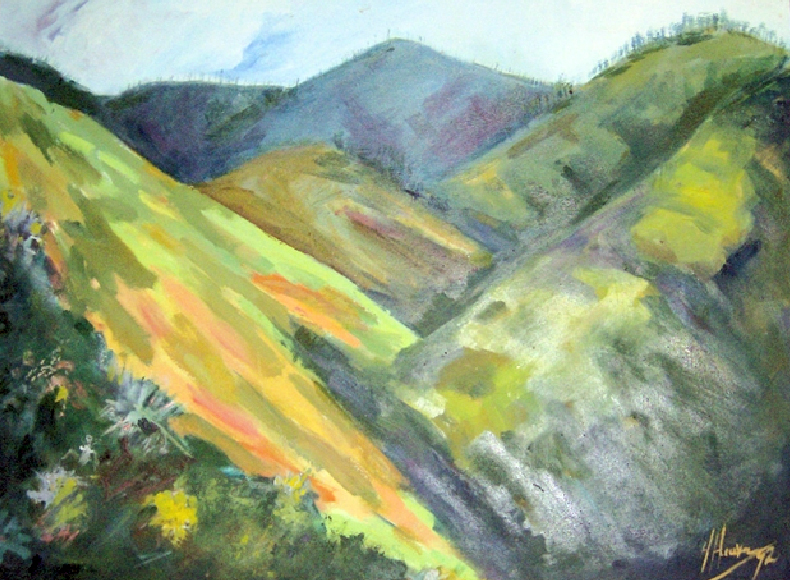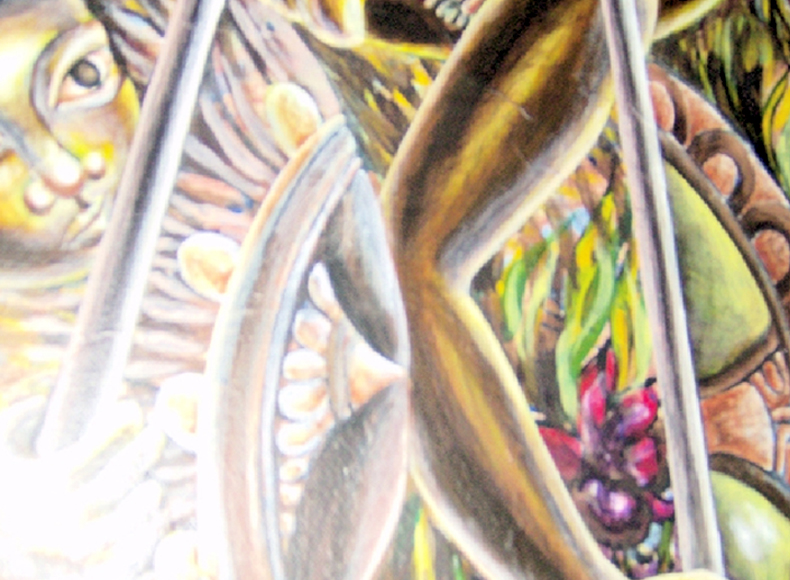Art As Investment – It’s not just for the filthy rich anymore
“I was fortunate in 1998 to obtain a Christopher Gonzales work which I called “Three Faces” for $12,000. I was sold (at a bargain) a Hopeton Fletcher surrealist piece for $5,000 in 1995. In May 2007, the Mutual Gallery sold the same pieces for me for $84,000. I made a whopping 394.12% profit ”
The last 15 years has seen a tremendous growth and progression in income of the Jamaican middle class.
Despite the economic doldrum over the island and fall off of traditional industries, individuals and families in the middle income strata have experienced more wealth than any other time in Jamaican history. The middle and upper class has never had it so good. To deny the financial benefits gained would be tantamount to heresy.
The liberalization of the economy, globalization,achievement of tertiary education and generally exposure to the previously hidden economies have benefitted the Upper and Middle Class significantly.
Suddenly with their professional skills, newly achieved business acumen, and talents many have found their coffers awash with cash, heavy cash in many cases.
Cash, liquidity, large disposable incomes were able to acquire stately homes in exclusive neighbourhoods, fine and sophisticated furnishings, and a horde of Japanese, American and European and motor vehicles. Wealth has also been diverted to acquire government papers, L.R.S.’s , Eurobonds, alternative investments and other securities, yet an excellent and non risky investment overlooked has been Jamaican Art.
Yes, Art has been overlooked as an excellent investment option. The rate of return on art investment has been so overwhelming. In the industrialized world, for example, investors in art profiteered immensely year after year. Even in a depression or a recession art has always command very excellent returns and sale prices. The auctions at Sotheby’s and Christies’s in New York or London tells that art is well worth pursuing.
Jamaica is no exception as collectors “bathe” in profits year after year. The fact is the art movement and market in Jamaica is extremely vibrant after a lull in the mid nineties. On the international markets collectors as far as Texas have gobbled up works by Jamaican painters such as Bernard Stanley-Hoyes, Susan Alexander, Dorothy Henriques – Wells, Kappo, Kafi, Edna Manley, Albert Huie, and Milton George . Paintings by these artists are in the in the homes of royalties.
Celebrities such as Roberta Flock have acquired many Kappo originals and Stanley Hoyes have exhibits at the Smithsonian Institute. Jamaican Art, inclusive of paintings, ceramics and sculpture has reached astronomical heights since the days of Edna Manley and her group of early painters. Our art has reached the zenith comparable to any in the developed world. Our artists are exposed and recognized. They are achievers nationally and internationally.
This piece by Lutolo McKonzi was appraised at $54,000 last year; I bought it for $20,000 in 1998”
Many have exhibited in Biennials abroad in countries such as Cuba, the U.S.A., South Africa, Brazil and Turkey.
Of course there are biases and prejudices in the international markets , but it is fair to say our artists have arrived. Many have been recipients of the Musgrave Medal.
Norma Harrick is recognized as one of the top 300 ceramics in the world in a Chinese publication some time ago. It is therefore, no co-incident that Art is an investment providing a high rate of
return. To state a point, I was fortunate in 1998 to obtain a Christopher Gonzales work which I called “Three Faces” for $12,000.00. I was sold at a bargain a Hopeton Fletcher surrealist piece for
$5,000.00 in 1995.
Last year May 2007, the Mutual Gallery sold the same pieces for me (At an Auction indeed ) for $84,000. I made a whopping 394.12% profit . That is what you call real investment. How can you go wrong?
You cannot go wrong. Although, the objective is art as investment, one should bear in mind that fine art by Jamaican accomplished artists are almost pleasantly aesthetic.
They do function as decoration, but an intelligently and intellectually inclined collectors should not collect for aesthetics but for investment.
Jamaican artists like other recognized artists utilize a number of media and styles. Oils, acrylic, pastels, charcoal, pencils, paper, newspaper, board, Styrofoam, sawdust, glass,
clay and of course the canvas are some of the material used in producing the final work.
Patience and Knowledge Important For Collecting Art
Do not jump to buy art because you find yourself with money and you want to keep up with the Jones’s or you will get burnt.
Do not rush to buy art because the artist’s name sounds good and the work is aesthetically appealing. Remember good works of art are accomplished pieces done with the most distinguished workmanship and materials. I observed many times that young professionals aping their friends , wanting to profile rush to a gallery or a frame centre and purchased someone’s work because it looks good.
That is a cardinal sin, a “Pentecostal feeling.” Education being more than a formal achievement can be obtained in a variety of ways. Collecting art for investment is not one which yield a return the next month or year like trading blue chip stocks. A rule of thumb is to keep your investment for at least four years before selling.
How can I know what is good art for investment?
My suggestion in educating yourself about art, especially for investment is to do the following:
1. Visit a reputable gallery and speak to the Curator or gallery boss. The Mutual Gallery in Kingston is one great gallery to visit. Its highly knowledgeable French Curator Gillou Baeur is always willing to discuss with you any thing related to Art. She is well informed and can assist you in making correct purchases and provide you with information on the artists whose works are recognized. The gallery also provides valuation services. Yes, you can get your works valued, especially paintings. The gallery provides monthly shows and has a motley of works for sale by many Jamaican artists. Prices vary and you will certainly find works to fit your budget. Importantly , the gallery has a long history of showcasing works over the years by top Jamaican artists. Mutual Gallery does not show mediocre works. As I recall speaking to Ms. Baeur, works are by artists who have been continuously producing. Other reputable galleries are Harmony Hall, Bolivar, Grosvenor Galleries, and Gallery Barrington.
2. Speak to a friend or persons who have been to many shows and can truly discern quality works at good prices.
3. Get your hand on art magazines, brochures etc. These can be obtained at the National Gallery, from individual artists and at the aforementioned Mutual Gallery.
4. Visit the Edna Manley College at graduation times, normally late May. Works of graduates can be an eye opener into future great artist.
5. Speak to established collectors who knows good works and the artists who produced them.
6. Just try develop an eye for smart pieces, use your intuition sometimes, it works.
What Prices Am I expect to pay for Investment Art?
The price expected to purchase a good work of art vary. It depends on whose work you are buying and certainly the source of acquisition. Gallery prices are loaded because like any business profit is the basic motive. However for living artists you can find out where you can contact him/her and the price will be naturally less, at least that is my experience.
“The last six years have seen great works and you can acquire these at prices from $5,000 to $40,000. By and large they are fine finishes, good styles and depict a variety of issues”
But the galleries do provide a good service especially for purchasing works of deceased artists and variety. Works by the masters such as Albert Huie , Edna Manley and Barrington Watson can run you over $150,000.00. Top of their class are also works by Stanley Bernard – Hoyes, Alexander Cooper, Dorothy Henriques -Wells, Gloria Escofrey, Susan Alexander, Brian McDonald, Cecil Cooper, Milton George, Lutola McKonzi, Carl Abrahams, Laura Facey and Christopher Gonzales. These artists works command prices from $60,000.00 to figures in excess of $150,000.00. Of course size of work and the media used account for price diffential. And as I mentioned if you know the artist I am certain you can use your negotiation skills to strike a deal. Jamaicans are very understanding people and no good offer is refused by a businesslike person.
Artists such as Hope Wheeler, Andy Jefferson, Michael Stanley, Errol Moo Young , Beverley Jackson, Hopeton Fletcher, Khepera Hatshepta, Ebony Patteron, Jerry Craig, Sheryl Champagnie, Hope Brooks are ome of the other recognized artists whose works are worthy of investment. For ceramics, the Master Cecil Baugh, and the accomplished Lutola McKonzi, Everald Powell, Phillip Supersad, Norma Harrick, Hopeton Dunn to name a few provide superior quality works. In sculpture, Gonzales working out of Runaway Bay , Ugandan born Mazola Mwashighadi and Laura Facey have produced excellent works.
Edna Manley College of the Visual Arts – A Bargain Centre:
If you have an eye for good works and for detecting potential great artists , then it is advisable to visit the final year show of graduates at the Edna Manley College. The show allow students to exhibit their best works and they are sold at reasonable prices. Mark you I think the last two years have seen expensive pieces, but you can negotiate with these students . They need the cash after expending so much money for material and their education in general. Edna Manley I think is a preview of what to expect from future great artists. The last six years have seen great works and you can acquire these at prices from $5,000.00 to $40,000.00 By and large they are fine finishes, good styles and depict a variety of issues. Some of their works speak to social issues bordering on class, politics, slavery, economics and life. Make the graduation an item on your social agenda. You will not regret going.
I appeal to you to go out and acquire your art. For those uninformed and naïve, take your time and learn. Observe my suggestion and follow through. You will be happy you make your purchase as you will be investing in “things Jamaican” and supporting our local artisans. You will also be placing an item or items to augment the ambiance of your residence. Walk good until the next issue. Next month we look at some artists, their works and styles.
Winston Donald is a noted local art collector who started his extensive collection of paintings and ceramics in 1983. He may be contacted for further queries or comments at:
If you like this article please consider joining our Forum HERE to help us grow.
Remember to share this article on Facebook and other Social Media Platforms. To submit your own articles please send us an EMAIL at: [email protected]. Subscribe to our mailing list to get new articles sent to you automatically.




I have two paintings by christopher gonzalez- originals purchased from personally- one painting of Malcolm X